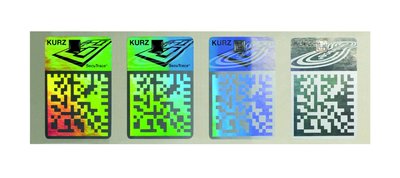How to change a 2D barcode into a design feature
Thursday, 25 April, 2013
Whether on a display panel, in a magazine, on a label or packaging, 2D barcodes attract attention, albeit for not being part of the aesthetics. Rather, you notice them because they interfere with the main picture. More often than not, they have not been blended into the global representation and therefore appear as an out-of-place element.
This does not have to be, as Leonhard Kurz will explain. The stamping foil manufacturer has developed diffraction 2D barcodes featuring attractive aesthetics, aiming at enhancing the product. Instead of being printed, the barcode is applied as a silver-coloured film stamp, encompassing the code itself, as a diffraction holographic-type addition.
The barcode area can be integrated into a larger metallised image, including holographic details. For instance, the code can be combined with optical security elements, making counterfeiting trickier. Design features specific to the brand can be integrated to the metallised area in order to fit the code appropriately in the brand logo. The 2D diffraction can also be integrated separately, thus enabling the customer to immediately identify the authentication element, enhancing the trust in the brand.

Although the Kurz diffraction 2D codes cannot be compared to those printed in terms of aspect, they are quite comparable when it comes to functionality. They can be read using a scanner or smartphone and offer the same direct and swift access to mobile information. Kurz has launched an internet identification system called Secutrace, which can provide a wide scope of product data for end users, retailers, customers or branded manufacturers. Such data is available in real time thanks to the 2D code. For instance, the buyer may check through his mobile phone that the branded product is genuine. Also, the 2D code opens access to lottery tickets, loyalty programs, product information or interactive games.
The Secutrace technology provides branded product manufacturers with access to micromarketing data and, therefore, to identify accurately their target markets in order to advertise customised offers. They can also guarantee the traceability of the product throughout the procurement chain. All information linked to the code is recorded, analysed and assessed through the identification system.
The branded product manufacturers can access this information at any time, which will provide them with accurate details on the product and they will also be made aware of parallel sales.
ST. ALi doubles capacity with second coffee packaging machine
In order to meet growing demand for its product, coffee brand ST. ALi has added another coffee...
Powdered plant milk designed to cut packaging and emissions
Bare*ly Mylk, a startup founded by Monash University alumni, has developed powdered plant milk to...
Linerless packaging design for kiwi fruit rebrand
Global kiwi supplier Zespri has collaborated with Tesco for its packaging revamp that is designed...














